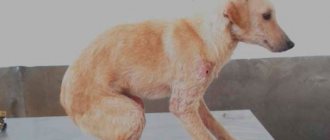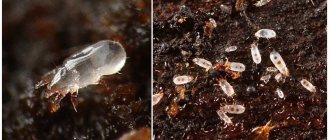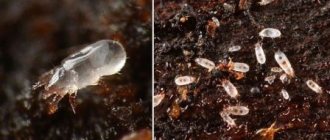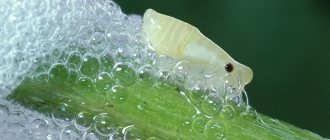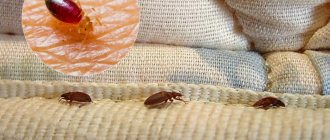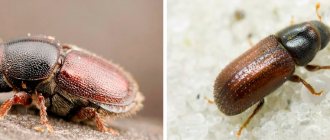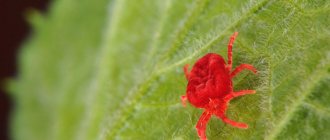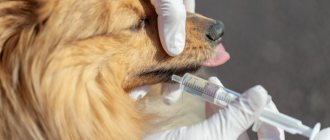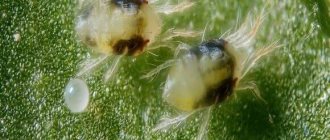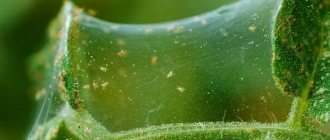Ear mites in rabbits cause the development of ear scabies and psoroptosis.
The pathology is characterized by itching and the formation of scabs on the ears of animals, and scratching leads to the appearance of wounds and the addition of a secondary infection.
The disease causes damage to farms: young animals infected by their mother often die, the weight and reproduction of livestock decrease, and the quality of hides and meat deteriorates.
Treatment of a simple form is carried out with antiparasitic agents, and preventive measures are taken to prevent infection.
How to detect an ear mite infestation
Detecting psoroptosis is quite simple. An examination of the animal is required. If the rabbit's ears are crusty (if the disease progresses) or there is inflammation at the base of the ear canal in the form of redness and bumps, then it is undoubtedly a mite.
There are other diseases such as notoedrosis, dermatophytosis and lice infestation, but all of them damage the animal's coat. In the case of psoroptosis, hair damage is rare ; in practice the rabbit dies before this happens. To make a diagnosis, the animal does not have to be taken to a veterinary clinic or veterinary station, but a scraping of the skin inside the ear is sufficient.
00:11
Chorioptosis. Cutaneous mite scraping of goat skin.
19:41
Study of mucous membranes and skin of animals.
01:21
WHY IS THE MATERIAL COLLECTED FOR HISTOLOGICAL STUDY?
You will need a cotton swab and any small jar with a tight-fitting lid. A scraping is taken with a cotton swab from the inner surface of the ear. It is then transported in a well-sealed container to the nearest laboratory.
If a sick animal is discovered on a farm, the following measures must be taken:
- check all the animals on the farm;
- isolate sick rabbits;
- disinfection of cages and rooms where sick animals stayed;
- disinfection of supplies and equipment;
- call the veterinarian!
When testing animals for psoroptosis, it is not recommended to transport them anywhere within the household. Once you have identified the sick rabbit, write down which cage it is in. Before proceeding, to avoid being a source of infection, wash your hands thoroughly with soap and check your clothing for any remaining earwax and pieces of discharged epithelium.
If the farm has a separate quarantine area, sick animals should be isolated from the main herd. If there is more than one animal in a cage, all rabbits in the cage will be quarantined. Contact animals are monitored for 5-10 days.
If ticks are not observed during this time, the animals are transferred to the main flock. Please note that the incubation period for possible infection is up to 5 days. As a preventive measure, such animals should be treated once with an acaricide, for example, Ivermek.
The cages in which animals were kept must be thoroughly disinfected. If they were made only from mesh, then you do not need to buy any special preparations. It is enough to have a gas burner and a piece of laundry soap in the house. First, the cage is well burned, especially corners and hard-to-reach places. After this, it is washed with a solution.
The solution is prepared as follows: one 200-gram piece of 65% laundry soap is dissolved in a 10-liter bucket of water. The cell is then thoroughly washed. If there are wooden elements in cage structures, preparations such as DEZ-1, Desoline-F, Agita 10% are used for disinfection.
Animal premises should be treated with iodine monochloride. Sold in veterinary pharmacies in canisters of 3 and 5 liters. It is applied as follows. Pour 200-500 grams of iodine into any open container and add a small amount of aluminum to start the reaction. This could be a piece of old wire or any aluminum shavings. During the reaction, a large amount of smoke is released, which is harmless to animals. Several containers can be placed around the perimeter of the room. Disinfection takes 30-40 minutes, after which the barn must be ventilated.
Equipment and tools used to work with animals should also be thoroughly cleaned. Thermal disinfection (fire, hot water) is most effective in this case.
If the disease has not yet developed into an epidemic, you can independently cope with ear mites in rabbits using acaricidal drugs. If this is not the case, you should seek professional help. Many registered farms are now under veterinary control.
In the case of psoroptosis, quarantine is carried out and all measures are taken to eradicate the outbreak. Unauthorized access is limited and the sale of livestock from the holding is strictly prohibited during this period. In case of violation, the farm may be subject to fines, including forced closure. Quarantine, at the discretion of the doctor, can last up to one month.
Symptoms
The insidiousness of this disease lies in the fact that the presence of a mite in the ears of rabbits is not immediately detected. However, if you are more careful, you will notice the following manifestations:
- severe itching: the animal itches, turns its head;
- small bumpy redness forms on the affected areas of the ear - a consequence of bites, then they turn into serous blisters;
- after a day or two, the vesicles burst, yellowish liquid flows out of them, forming grayish crusts when drying;
- The production of sulfur increases, it is concentrated in the ears in the form of brown-yellow lumps.
If this problem is neglected, the number of crusts in the ears can increase significantly. This is already fertile ground for the development of harmful bacteria that will negatively affect soft tissues. An additional risk is that microorganisms may travel further, i.e. into the animal's brain, and this can already lead to death.
It is important to monitor your rabbits for early signs and symptoms of mite exposure. The sooner you notice changes, the sooner the treatment process can begin, which can be quite lengthy if the situation is ignored.
Sources of infection
Rabbits can get ear scabies at any time of the year, but it most often occurs in the fall and winter. Routes of infection:
- Pets;
- host (ticks live peacefully without a primary host for 11 days, including on human clothing, and are easily transmitted to other animals);
- care elements;
- a cage in which sick rabbits used to live.
Purpose
Acaromectin is used to treat parasitic diseases in rabbits. List of pathologies for which the drug helps.
- Sarcoptic mange is a contagious disease caused by itch mites.
- Notoedrosis is an invasive disease, the causative agent is the scabies mite.
- Otodectosis - ear scabies.
- Entomoses caused by fleas, lice or lice.
- Demodectic mange is an infection caused by ear, subcutaneous or fur mites.
Ivermectin in the composition changes the magnitude of the current of chlorine ions.
Because of this, the conduction of nerve impulses is disrupted, and the functioning of the nervous and muscular systems malfunctions. The parasite becomes completely immobilized (paralysis), followed by death. ATTENTION! When applied to the skin, Acaromectin has a contact effect in places where parasites accumulate.
After absorption, a systemic insectoacaricidal effect begins - the substances enter the general bloodstream and tissues, killing parasites “from the inside.” According to the degree of danger, Acaromectin has class 4 - these are low-hazard substances. If the dosage is observed, it does not have an irritating, toxic or mutagenic effect. Well tolerated by adult rabbits. Not recommended for treating emaciated, pregnant, lactating animals, as well as animals under 1 month old.
The causative agent and consequences of scabies
The cause of the disease is the microscopic mite Psoroptes cuniculi. It can be found everywhere and at any time of the year. The size of the pest is between 0.4 and 0.8 mm and can only be examined under a microscope or a high-powered magnifying glass. The body is elongated, round and yellowish in color.
Parasites are on the inner, open surface of the ear, because there is the greatest concentration of small blood vessels. The consequences of psoroptosis at an advanced stage are as follows:
- significant weight loss;
- male refusal to mate;
- a woman's reluctance to care for her offspring.
Damage to the ear can be so severe that the animal cannot even navigate in space and coordination of movements is impaired.
If the owner does not treat ear mites in rabbits in a timely manner, the parasite quickly multiplies and penetrates the middle ear, risking causing otitis media, encephalitis and death of the rabbit.
Symptoms
This disease is very insidious because it is most often not detected immediately. However, if you are attentive to the animals on the farm, then ear scabies can be detected by some symptoms:
- the animal becomes more irritable and aggressive;
- Appetite is significantly reduced, so weight loss is observed;
- The rabbit often shakes its head from side to side.
If such symptoms appear, it is necessary to carefully examine the ears of the rabbits. If there are red blisters, this is a clear sign that the animal is suffering from tick bites.
Laboratory analysis of scraping the epidermis from the ear helps to accurately diagnose the disease.
Laboratory diagnostics can detect parasites and their eggs in scrapings taken from the animal’s ears. A similar study can be carried out without using a microscope: scrape a little skin from the surface of the inner part of the ear and stir it in warm (heated to 40 degrees) Vaseline oil - small arthropods will be visible under a magnifying glass.
You can learn about the main causes of psoroptosis and methods of its treatment from the following video:
The sooner the owner detects the disease in the rabbit, the faster and easier the treatment will be. In advanced cases, the process of ridding an animal of ear mites can take a long time. The lack of adequate treatment leads to the formation of a large number of scabs and hard crusts in the animal’s ears, which are an ideal environment for the development of harmful microorganisms.
The photo clearly shows what an advanced form of psoroptosis looks like in a rabbit
How do rabbits become infected with ear mites and how does it develop?
The source of the infection is a rabbit infected with scabies; mites fall out of its ears along with peeled flakes of skin and scabs and move onto healthy animals.
Infections occur:
- in close contact;
- through objects, bedding, feeders, owner’s clothes and livestock;
- when transporting healthy rabbits to the room where sick rabbits were kept.
In rare cases, cats or dogs accidentally introduced into a dysfunctional household may bring insects into the household.
Factors contributing to the development of the disease:
- cramped conditions in the cage;
- humidity;
- regrouping of animals;
- malnutrition.
Latent transmission, where adults and nymphs inhabit the outer ear of apparently healthy rabbits, plays a significant role in the spread of infection.
When optimal conditions arise for the continuation of this cycle, arthropod parasites become active, causing an outbreak of disease in the herd.
Phases of development
After penetrating the skin of the ear, mites begin to actively reproduce, with one female laying up to 60 eggs, which are attached to the skin scales with uterine secretions.
The further life cycle includes the following stages of development:
- Larva. It has 6 legs and emerges on average after 4 days. The larva appears after 2-3 days.
- Proto-nymph. This is the next stage nymph.
- Teleonym. Preparatory stage for maturation.
- Adults. Men reach puberty 2 days earlier than women.
Given adequate temperature and humidity, development time for males is limited to 14 days, while females mature in 16 days. The parasite lives for 2 months on the skin of a rabbit.
It is necessary to contact your veterinarian to confirm the diagnosis.
Infected ticks pose a risk in spreading disease.
Routes of infection
Most often, a rabbit becomes infected with ear mites through direct contact with a sick animal. The carrier of a parasitic infection can be not only another rodent, but even a cat or dog.
There are other ways of transmitting psoroptosis:
- From a sick female to rabbits.
- Through the cage and inventory. If among the rodents living together at least one gets ear mites, his neighbors will also get sick.
- Through a person. The owner of a rodent can bring ticks into the house on clothes or shoes. Over time, the parasites will penetrate the rabbit's ear and begin to multiply there.
Attention! The spread of ear mites is facilitated by crowded housing of rabbits, poor nutrition, unsanitary conditions and high humidity in the room where rodents live.
Treatment procedure
Before starting the procedure, it is necessary to get rid of the crusts and scabs that are on the inside of the ears. This is done as follows:
- First, the rabbit must be securely restrained so that it is completely immobilized. Be careful because rabbits have very strong back legs that can injure you.
- Take a cotton ball and then soak it in hydrogen peroxide or Vaseline.
- Treat all scabs with a swab until completely softened. Of course, treatment should be carried out with gloves.
- All collected casings must be isolated as they contain large numbers of bacteria and mites. They can then be disposed of using chlorine or burned in a fire.
You can treat a rabbit for ticks yourself or with the help of a qualified veterinarian, so everyone chooses the appropriate option for them.
Treatment is most effective and rapid if it begins during the incubation period, i.e. during the first five days after infection.
Various aerosols containing hiodrine, chlorophos or neocidol are widely used in treatment. They should be applied as follows:
- The spray container should be 15 cm away from the rabbit ears.
- Spraying occurs within one minute.
- Spray the product onto the inside of your pet's ears.
But how Strakach rabbits are bred and how they are described, see here.
The use of aerosols has proven to be very effective.
Along with medicinal drugs, you can use traditional medicine, which have also proven effective in the fight against ticks. However, it is important to understand that they are only effective when used in the early stages of the disease.
Here are some popular recipes:
When assessing the effectiveness of drugs and folk remedies, preference is given to traditional methods of treatment. The effect of their action occurs almost after the first use, but the course of treatment with folk remedies may take several days or weeks. But in the absence of alternatives, they can also be used.
Efficiency
Acaromectin is a highly effective remedy. Efficiency has been confirmed in clinical studies and experiments. The tests were carried out in Moscow, the initiator was JSC Narvak.
Calculations were carried out empirically, type - critical test. The effectiveness was confirmed to be 85.7% with a single use and 100% with a double treatment according to the scheme. The test animals showed complete freedom from parasitic mites.
The substances in Acaromectin have a detrimental effect not only on adult individuals, but also on their larvae. Therefore, the use of Acaromectin will be effective at any stage of development of a parasitic disease. The effect of the drug begins immediately after contact with the skin of a sick animal.
Methods of treatment with medications
To treat ear mites in rabbits, pharmacological procedures are used in the form of sprays, drops and injections. When taking medications, injections and irrigations are used:
- Ivermectin or Ivermec is administered subcutaneously or intramuscularly;
- Baybek and Ivomek are injected into the back of the head (in consultation with your veterinarian);
- Butox 50 (in ampoules) irrigate the ears with a solution prepared in the following proportion: add 1 ampoule to one liter of water.
Dent and Valexon drops are introduced into the ear canals in accordance with the instructions for use for 14 days at intervals of a week. Three drops of Strength are also used. Positive results are noticeable after the first use of the drug.
The spray is sprayed at a distance of 1520 cm from the ear for 12 seconds, directing the spray to the inner surface of the ear. The most common of them:
- Chlorophos;
- Siodrin;
- Sulfidophos;
- Dicresil;
- Psoroptol;
- Sulfidophos;
- Akrodex.
Ear treatment is carried out once a week, treatment lasts 14 days. A positive result after the first use is observed in 80% of cases.
Ivermek for rabbits
The active ingredients are ivermectin and vitamin E (10 and 40 mg per 1 ml of the drug, respectively). The composition also includes auxiliary elements to achieve the required consistency.
The drug "Ivermek" is available in three forms:
- gel;
- solution for intramuscular injection;
- Ivermek spray for rabbits.
Ivermek for rabbits as an injection solution is a clear, colorless liquid with a weak, specific odor. It is poured into bottles of different sizes. This form is designed to kill internal parasites. That is, parasites that live in organs (such as nematodes, tapeworms, etc.).
Ivermec gel for rabbits, according to the instructions, is intended to combat skin parasites. For example, against lice there are many varieties of subcutaneous mites. It is easy to use and does not require special veterinary skills. In addition to vitamin E and ivermectin, rabbits contain panthenol and lidocaine. They promote rapid healing of skin damage.
The instructions for using Ivermec rabbit spray state that it can only be used externally, after wearing gloves. This form of medication is intended to kill external parasites (lice, fleas, etc.).
Directions for use and indications for use
Ivermek in rabbits is recommended for the following pathological conditions:
- demodicosis;
- sarcoptic mange;
- Scabies;
- helminthiasis;
- psoroptosis;
- lice and fleas;
- toxaxariasis;
- esophagostomosis;
- trichocephaly;
- cestodosis;
- nematosis and other parasite infections.
The gel is applied in a thin layer to the affected areas of the skin. Although the Ivermec dosage for rabbits is similar for animals of any body weight, consultation with your veterinarian is still necessary. He will determine how long and how often to use the drug. The usual duration of use is 7 days with a frequency of 2-4 times a day. Ivermec veterinary instructions for use on rabbits state that spraying should be done in small quantities and only on affected areas.
Ivermek for rabbits, the dosage of the solution for intramuscular injections for toxaxarosis, toxacariasis, nonsinariasis, sarcoptic mange, otodectosis, demodectosis, fleas is 0.1 ml per 5 kg of body weight. The initial liquid must be diluted directly in the bottle with special water for injection. Ivermectin for rabbits, in accordance with the instructions for use, is not recommended for young animals with low weight.
Dosage for other animals is indicated in Ivermek's instructions. Consult your veterinarian in advance. In some cases, he may adjust the dosage for a better therapeutic effect.
Contraindications for use
Ivermek for rabbits in accordance with the instructions has the following contraindications:
- presence of an infectious disease;
- weakened state of the animal;
- last trimester of pregnancy;
- less than two weeks.
If the animal has the conditions mentioned, then the use of Ivermec for rabbits should be postponed. If the drug has already been used, it must be stopped immediately.
Analogs
The most popular medications for pets with a similar active ingredient are:
- Ivomek;
- Iversect.
These drugs are available as a solution for intramuscular injection. They have the same effect as Ivermek.
Description and composition of the drug
The dosage form of the drug Acaromectin is a clear solution with a mild odor. Packaging varies: from 10 ml to 500 ml. Available in polyethylene bottles equipped with an aerosol spray. Large volumes are sold in glass or polymer bottles. Sold without a veterinarian's prescription.
The main active ingredient in the composition is ivermectin. This is a natural substance (a product of fermentation of soil fungi Streptomyces). It is a natural antibiotic, insecticide and acaricide. Auxiliary elements in the composition are isopropyl alcohol and mineral oil extract.
Folk remedies for treating ear mites in rabbits
Experienced rabbit breeders, after discovering psoroptosis in their breeding herd, usually use proven traditional methods of treating the disease. It is usually cheaper and in many cases just as effective as medications. Kerosene, camphor or sunflower oil, iodine, honey - all these remedies have long proven themselves in practice and are more or less effective.
Kerosene in its pure form is not recommended for treating ear mites in rabbits. It must be mixed with vegetable oil in a 1:1 ratio. Initially, 3% hydrogen peroxide is used to moisturize the affected areas. The detached epithelium and excess wax are removed. A thick layer of the prepared solution is applied to the infected area and 2-2.5 ml is poured directly into the ear canal. Treatment is repeated after 3-5 days.
Thorough cleaning of the ears is not recommended. Under no circumstances remove growths from the eardrum cavity or damage them mechanically. Handle affected areas very carefully!
When treating with iodine, it is necessary to treat the auricle of the affected animal once every two days. Glycerin is added to the prepared solution in a ratio of 1/4. The affected areas are watered abundantly. Torn pieces of skin are removed. The procedure is repeated until the animal recovers completely.
If the disease is detected at an early stage, rabbit ears can be treated with honey. To prepare the solution, boiled or distilled water is required. For every 100 ml of water add 3 teaspoons of honey. Generously moisten the affected areas with the prepared solution.
Camphor oil is another effective folk remedy for ear mites. Experienced rabbit breeders recommend treating them without resorting to other methods. It has soothing properties and surrounds the treated area with a thin film, which prevents further development of the disease.
The oil can be used pure or mixed with turpentine or kerosene in a 1:1 ratio. A needleless syringe is required for use. Infected surfaces are carefully moistened. Separate pieces of crust, ear series are removed. This procedure must be performed daily.
Is it only the scabies mite that lives in a rabbit's ears?
In rabbits, cutaneous parasites are localized and multiply directly in the ears, but sometimes they crawl onto the body and stay there for some time, and then move on to other animals.
Ticks are found on the skin of the neck and back, extremities with a strong spread, where they get due to scratching.
This is interesting! It is assumed that attachment to the habitat on the body of lagomorphs is associated with insignificant sweating in this area.
Complications caused by psoroptosis
- As the disease progresses, the itching in the ears may almost stop. The next stage begins when small ulcers appear on the neck, behind the ears, which then move down to the front legs.
- If liquid exudate comes out of the ear, this means that the eardrum has begun to rupture. This in turn leads to otitis media followed by meningitis. A ruptured eardrum can cause the animal's head to tilt and the ear to droop on its own.
- Frequently shaking the head and ears of a sick rabbit can cause lymph nodes to rupture.
All these reasons, if not eliminated in time, will subsequently lead to the death of the animal.
Pathogens of the disease.
Ear mites in all their glory.
Scabies is caused by Otodectes cynotis , which, penetrating deep into the skin, affect the nerve endings and thereby cause itching. Hence the name of the disease - otodectosis. At further stages, deeper areas are affected, which leads to damage to capillaries and blood vessels. They penetrate the skin by biting it with the mouth. Ticks have a body size of less than a millimeter and are not visible to the naked eye. However, with the help of a magnifying glass you can see them and even see how they move. The body shape of the parasites is oval and flat, the color ranges from yellowish to dark yellow. They reproduce by laying eggs. The time cycle of development of one generation is relatively long. For males it is 16-19 days, and for females it is 19-25 days.
Prevention of ear psoroptosis in rabbits
To prevent the development of psoroptosis on a rabbit farm and at home, it is important to use preventive measures, including compliance with sanitary and hygienic standards and animal hygiene standards.
Required:
- Check your rabbit's ears regularly for parasites;
- Isolate the animal if infection is detected or suspected;
- Source livestock only from disease-free farms;
- keep animals in quarantine for at least one month, during which they are examined for psoroptosis;
- at least once every 6 months, disinfect cages and rabbit buildings, as well as treat livestock and disinfect clothing.
To prevent infection of young animals, healthy males are selected for mating, and rabbit ears are examined 2 weeks before mating.
If an infection is found, the area is treated with a topical antiparasitic as directed by your veterinarian.
On a note.
You can also use any used technical oil, ASD-3 helps a lot. (ASD-3 /DOROGOV STIMULANT, FRACTION 3/ is a product of dry distillation of raw materials of animal origin. Accelerates the regeneration of damaged tissues, has a pronounced antiseptic property.)
Creolin does an excellent job, but it has a strong unpleasant odor. You can also use regular turpentine and half and half vegetable oil; you can also use machine oil. There are no restrictions; nursing and pregnant rabbits can also drip. It is easy to notice an affected rabbit; it often shakes its head. Infection occurs through grass and hay. Especially if old straw and hay are placed in the nest boxes. Last year's or even older. Cats love to sleep in hay, and they are carriers of ticks. As well as mice and rats. When vaccinating or other cases when you pick up a rabbit, do not be lazy to look into its ears. The disease is not terrible if detected in time.
